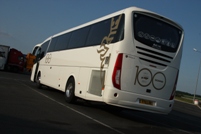
Order bookings for buses and coaches decreased by 25% compared to the same period in 2011 while net sales of buses and coaches rose by 4%
Scania’s first quarter financial report claims lower vehicle deliveries and lower capacity utilisation pulled down earnings, as did higher costs for future-related projects.
Operating income fell to SEK 2,323m (3,339); earnings per share fell to SEK 2.24 (3.14) while net sales decreased by 3% to SEK 20,127m (20,692).
Leif Östling, Scania President and CEO, said: “A more favourable market mix had a positive effect, as deliveries in Brazil were supported by some 2,000 Euro 3 vehicles during the first quarter. Total deliveries fell due to a deceleration in demand in late 2011. Scania has adjusted its production rate to the current level of demand. The market in southern Europe is still at a low level. Order bookings in Latin America were adversely affected during the quarter by the transition to Euro 5 vehicles in Brazil. In Eurasia, demand remains at a good level. Order bookings in the Middle East were still at a low level and the outlook is uncertain. Elsewhere in Asia, an increasing interest in Scania’s high quality products and services is discernible.
“Engines noted higher order bookings, mainly driven by Europe. Demand for service is generally at a high level, with growth being driven by Latin America. Scania is wellpositioned in the market through its latest and product releases.”
Trucks and buses order bookings were down 19% from 19,457 in 2011 to 15,809, with deliveries down 15% from 19,065 in 2011 to 16,238.
Order bookings for buses and coaches weakened during the first quarter, mainly attributable to Europe, compared to the end of 2011. Scania’s order bookings for buses and coaches decreased by 25% overall to 1,574 (2,103) units during the first quarter of 2012 compared to the same period in 2011, while net sales of buses and coaches rose by 4% to SEK 1,449m (1,398) during the first quarter of 2012.
In Europe, order bookings decreased by 41% compared to the first quarter of 2011. The company claims the downturn was due to a major order in the Netherlands which was recorded in the first quarter of last year.
Order bookings in Latin America were adversely affected during the quarter by the transition to Euro 5 vehicles in Brazil. Order bookings also decreased in Chile and Argentina.
In Asia, orders fell by 34% compared to the first quarter of 2011, mainly related to the Middle East. Orders in Africa and Oceania increased by 84%.
Scania’s bus and coach deliveries totalled 1,389 (1,503) units during the first quarter of 2012. In Europe, deliveries fell by 5% compared to the first three months of 2011. In Latin America, deliveries were essentially unchanged at 572 units. Deliveries in Brazil were supported by some 250 Euro 3 buses during the first quarter 2012. In Asia, deliveries decreased by 34% while bus and coach deliveries in Africa and Oceania rose by 46%.
Vehicle production has been adjusted to the current level of demand in two steps. In November 2011, Scania lowered the daily production rate on a global basis by about 15% compared to the end of the third quarter of 2011. Starting in January 2012, the daily production rate was further lowered by about 15%. The changeover to the new engine range in Latin America was completed during the first quarter.
Scania will construct an industrial facility near Bangalore during the coming year. The facility will be the centre of Scania’s commercial operations in India. The industrial operations will consist of final assembly of truck and bus chassis, bodywork and fitting out of complete vehicles. Production is expected to start in early 2013.


